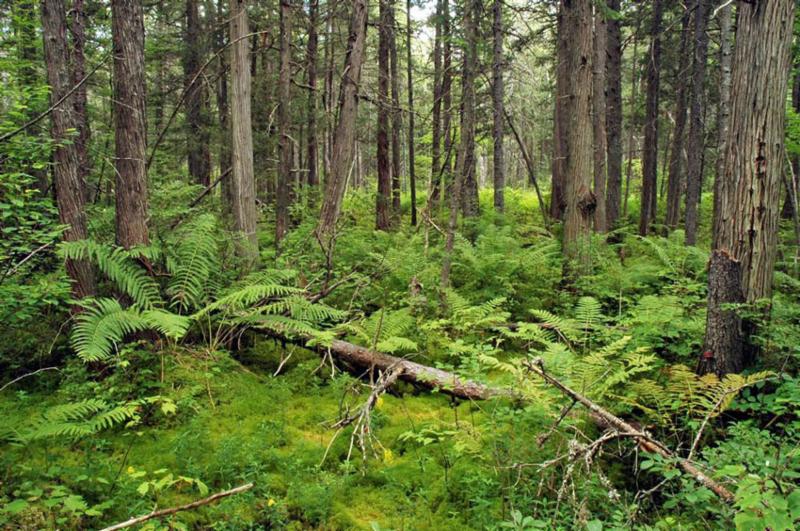This month, we thought it was important to review just how much the combination of Northern White Cedar and our advanced milling techniques can mean in true savings for our customers. It’s hard to imagine a better combination of quality materials, precision cutting and low environmental impact than what we offer. This combination can provide benefits in ways that don’t occur to our competitors.
 Save Energy
Save Energy
We’ll start with the most long-term benefit to building a Katahdin Cedar Log Home – saving energy. Northern White Cedar has one of the highest R factors of any species, 1.41-R per inch of thickness. Pair that with the Energy Envelope System® and our homes are designed to be as energy efficient as possible. Ensuring that a home is as well insulated and tightly constructed as possible is a pennies-on-the-dollar investment over the lifetime of a home.
Over the years we’ve perfected our insulation system and building techniques to ensure each home is tightly constructed to keep heated and conditioned air where it needs to be: inside. We test that precision crafting each time we run a blower door test on a home to identify where tiny gaps might need filling before final finish work starts.
Katahdin’s complete package also ensures that essential components needed for a well constructed home are included and milled expressly for their place in the envelope. For example, windows and doors openings are most susceptible to air leakage in any home. In log homes, fittings that hold and attach windows and floors are call bucks. They help to hold the window and door openings square as the log walls rise. Katahdin packages include pre-cut window and door bucks-again precisely cut in our mill- so that on-site assembly goes quickly and windows and doors are set properly.
Save Time
Katahdin has perfected our computerized house line to ensure one of the most precise and well-crafted log homes available. This computer precision translates into time saved during construction. The house design is sent electronically to the house line, where each row, or course, of logs is precisely cut, notched, drilled and finished. Each log fits exactly where it needs to go according to the final plans. The logs are marked with an identifying number and barcode, then packaged efficiently according to the build plan so that no more than two bundles need to be open at once. Each pallet of numbered and coded logs is sealed in water resistant, breathable packaging to maintain dry and clean logs. And because the bundles are unpacked in the order they are needed, logs stay out of the elements until the home is closed in.
Gone are the days when a builder needs to completely unpack and sort logs before he starts laying the logs on the foundation. This hand sorting often took a day or two depending on the size of the home. Some companies maintain an even more rudimentary assembly with notching and cutting for every log on the exterior shell occurring on-site. The amount of time saved at the home site with Katahdin’s well-organized, pre-cut, computerized system can really add up. And saved time means less construction labor costs.
The Energy Envelope System® (EES) also offers another major time saving benefit when compared to old-school log homes, where each log must be drilled to accommodate wiring and plumbing. With EES, plumbing and electrical wiring can be applied directly to the inside log walls, where it is concealed behind the insulation, strapping and tongue-and-groove paneling that completes the wall system on the interior side. On an average sized home, the time saved from this simplified work can easily amount to thousands of dollars, which can be invested in other features within the home.
 A Greener Construction
A Greener Construction
Northern White Cedar is a low-maintenance wood species that comes by its durability naturally. Cedar produces oils are unpalatable to insects – one of the reasons cedar is used in closets and blanket chests. Cedar’s natural insect resistance translates well into its sustainability in the wild, and is one of the least threatened tree species in North America. It grows naturally and in abundance without the need for intensive farming, insecticides or fertilizer.
Cedar’s low moisture level ensures that cracking, checking and settling are minimal. Cedar also discourages the growth of mold. Lower moisture levels means that Katahdin is able to season and dry our cedar logs outside, with just a trip through a finishing kiln to ensure an optimal 10-12 % moisture level.
We also take the natural “green” element of cedar to the next level by using every last bit of the tree during our manufacturing process. Bark and slabs are processed for mulch. Higher grade logs are set aside for log wall stock, while others are designated for cedar fencing, rails, tongue-and-groove paneling, and outdoor accessories constructed at our subsidiary, Cedar Ideas.
Even the waste products of sawdust and shavings are fed into our industrial biomass boiler to create steam heat for the mill buildings in winter and to run our finishing kiln. This enables us to almost completely cut the use of fossil fuels in our manufacturing process.
“Available in Cedar”
This is a catch phrase we often see in materials making the rounds of log home shows and magazines. And yes, these folks can probably design a home constructed in cedar. However, it’s a common misconception that cedar as a log species is much more expensive than other species. More often than not, cedar is used as a cost comparison tool to camouflage its benefits over pine and other softwoods. Cedar only costs more when you have to source it as a special order. And sometimes, the special cedar is not the top grade log wall stock we insist on using for our log homes. Katahdin specializes in cedar because we know it’s the superior wood to use in log homes. And it’s why we’ve become the largest processor of Northern White Cedar in the U.S.
